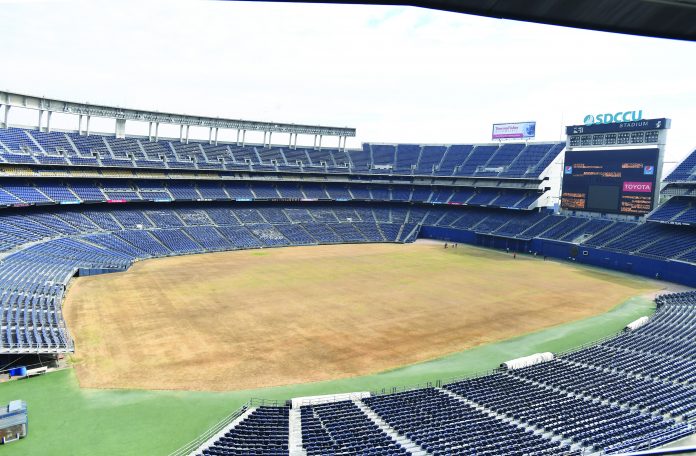
It is said that all good things must come to an end. But in the case of SDCCU Stadium, the end is not particularly good.
The facility that first opened in 1967 and has given San Diegans so many memories currently sits on its parcel in Mission Valley decrepit and in disrepair.
It has become an eyesore much to the chagrin of longtime fans.
The site recently changed ownership from the City of San Diego to San Diego State University at a cost of $88 million. The university plans to build its own 35,000-seat stadium on the mix-use development site that will expand the university’s educational, research, entrepreneurial and technology transfer programs as well as feature 80 acres of parks, recreation and open spaces.
The 166-acre Mission Valley project — the region’s first major sports and entertainment venue to be developed since the opening of Petco Park in 2004 — is expected to deliver immense benefits to the community for generations to come.
The $350 million expansion will allow the university to gradually increase enrollment by up to 15,000 students; it is expected to expand the university’s economic impact in the region by $3 billion annually.
With progress, of course, comes change.
However, change will not be immediate. The site will be developed over the next 15-20 years.
The first project to rise out of the dust will be the new Aztec Stadium, which is expected to open in 2022. The parking lot adjacent to SDCCU Stadium has already been torn up and the underlying dirt is in the process of being graded.
The new stadium will sit immediately to the west of the old stadium, still within close proximity to the trolley platform.
The old stadium site will be flattened to the ground to accommodate other building projects. There will not be a spectacular implosion of the structure but “deconstruction” of the massive concrete framework. It will be brought down in phases by a wrecking ball, likely over a several month period.
The wrecking ball method was preferred for environmental concerns due to the large volume of dust that would further reduce air quality in the area.
End of an era
SDSU has elected to deconstruct the stadium in the first quarter of 2021 ahead of schedule to help advance the timeline for the entire project.
As a result, the Aztecs will play all their home games for the 2020 and 2021 football seasons at Dignity Health Sports Park in Carson — 110 miles to the north.
SDSU has not wasted time in bringing its new vision for the Mission Valley site to the table.
Local media was given a final tour of the deteriorating 53-year-old facility on Oct. 6.
The stadium, as it exists now, could not host a football game. The grass on the field is either dying or already dead, the scoreboard is garbled, stairwells are rusted, seats have faded and weeds are growing between them.
It would take a big investment in funds — millions perhaps? — to put on games there. Those are funds that could be put to better use elsewhere, hence the move to Carson.
There certainly has been a lot of memories at the aging facility that has alternately been called San Diego Stadium (1967-80), Jack Murphy Stadium (1981-97), Qualcomm Stadium (1997-20917) and SDCCU Stadium (2017-2020).
Throughout its history, the Mission Valley stadium was the destination site for high school baseball and football championship games.
For instance:
The 1985 Class 3A title contest pitted Helix against a Vista Panthers team that has since been hailed as the best-ever prep football to emerge in the region. Vista won that game 35-7 after the Highlanders had ended Sweetwater’s vaunted 36-game winning streak with a 15-6 victory in the semifinals.
Helix had a chance to redeem itself in the 2001 final by defeating Oceanside, 41-30, in a match-up of the top two ranked Division II teams in the state.
The Highlanders, keyed by quarterback Alex Smith (the No. 1 pick in the 2005 NFL Draft out of the University of Utah), successfully defended their 2000 section title and won for the third time in four years.
Helix defeated Chula Vista, 19-7, to win the 1998 Division II title.
Monte Vista, under current Southwestern College coach Ed Carberry, defeated Helix, 20-3, to win the 2003 Division II title.
On the baseball diamond, the Grossmont Foothillers defeated the Mission Bay Bucs, 3-0, to capture the 1991 Class 2A title.
However, the stadium is best known for hosting college and professional sporting events, as well as concerts.
Local fans had the chance to cheer on the Padres (1969-2004), Chargers (1967-2017) and San Diego Sockers (1978-83) during their respective tenures in Mission Valley.
The stadium has hosted three Super Bowls (1988, 1998 and 2003), two Major League Baseball All-Star Games (1978 and 1992) and two World Series (1984 and 1998).
It has also hosted many soccer events, including the 1982 North American Soccer League Soccer Bowl and 1999 Major League Soccer All-Star Game as well as international friendlies.
Other major events included international rugby, supercross and Monster Jam (before the latter two moved to Petco Park in 2015).
The Rolling Stones, The Who, Pink Floyd, Guns N Roses, U2, Metallica, Eagles, Elton John and Bob Dylan are among the celebrated artists who have serenaded fans at the massive facility.
The Holiday Bowl has been a staple at the Mission Valley complex since its debut in 1978. The Poinsettia Bowl enjoyed a 12-year run at the facility.
SDCCU Stadium hosted its last Aztec football games last November — both wins.
SDSU defeated Fresno State, 17-7, on Nov. 15 behind a career-high 323 passing yards from quarterback Ryan Agnew.
The Aztecs’ final regular season game of the 2019 season — and final SDSU game at the venue — was a 13-3 victory over Brigham Young University on Nov. 30. A pair of San Diego natives led the way for the hosts as safety Tariq Thompson (St. Augustine High School) had nine tackles, an interception and a strip-sack fumble recovery, while quarterback Carson Baker (Helix Charter) won his collegiate debut by completing 19 of 24 passing attempts for 172 yards and one touchdown.
The final football event at the stadium was the 2019 San Diego County Credit Union Holiday Bowl on Dec. 27 in which the Iowa Hawkeyes defeated the University of Southern California Trojans, 49-24, in front of 50,123 fans.
Some stadium seating and parking lot mementoes will be saved for possible sale to the public.
The iconic statue of Jack Murphy is expected to be moved to the new stadium.
The old stadium, once broken up, will serve as landfill for the new stadium, which will be raised above the 100-year flood plain.
In the beginning
Stadium construction began one month after a $27 million bond was passed in November 1965. The original capacity was 50,000 for baseball and 52,596 for football.
The San Diego Chargers, then members of the American Football League, played their first game at the Mission Valley complex on Aug. 20, 1967. It came six years after the team had moved from Los Angeles.
San Diego State’s first football game in the facility came on Sept. 15, 1967, when the Don Coryell-led Aztecs defeated Tennessee State 16-8.
The San Diego Padres played their final 1968 Pacific Coast League season at the stadium before making their Major League Baseball debut in 1969 as part of four expansion teams.
The first concert held at the venue followed a Padres game on June 4, 1972.
The KGB Sky Show moved to Mission Valley in 1977.
The stadium expanded to 61,000 seats and 50 suites at a cost of $9.1 million in 1978 and underwent further expansion in 1997 with the addition of 10,500 seats, 34 suites, four club lounges, upgraded food services and two video scoreboards at a cost of $78 million (along with a new practice facility for the Chargers) to bring the seating capacity to 70,561.
The Padres hosted Game 1 and Game 2 of the 1984 World Series at the stadium.
Super Bowl XXI between the New York Giants and Denver Broncos took place at the stadium in 1988 — the first of three NFL championship games to call San Diego home.
The 1998 calendar year proved to be a spotlight for the facility as the Broncos (led by John Elway) defeated the Green Bay Packers (led by Brett Favre), 31-24, to win Super Bowl XXXII and the Padres hosted the New York Yankees in the third and fourth games of the World Series.
The jump to the new millennium was eventful as the Tampa Bay Buccaneers defeated the Oakland Raiders, 48-21, in Super Bowl XXXVII.
The Chargers hosted the Raiders in the 1980 AFC championship game, with the Raiders scoring a 34-27 victory to advance to Super Bowl XV.
QB Dan Fouts passed for 336 yards in the loss, with two touchdowns to Charlie Joiner.
Most recently, the San Diego Fleet of the short-lived Alliance of American Football called the stadium home during the spring of 2019.
After the departure of the Padres and Chargers and the folding of the AAF, the Aztecs and Holiday Bowl were left as the stadium’s major tenants.
In fact, the configuration has been left for football games, with the Padres’ old dugout hidden beneath a deck of movable seats.
It’s an altogether unglamorous ending.
There will be no fireworks — the 2020 KGB SkyShow has been canceled — only the sound of crashing concrete at the mercy of the wrecking ball.
Rodney Dangerfield, in fact, may have gotten more respect than the stadium has in its declining years.













